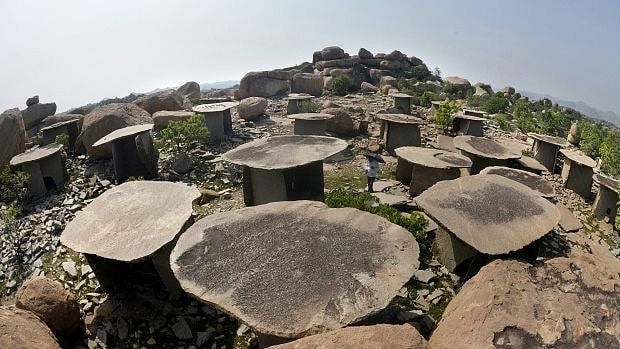
The Hirebenakal megalithic site in Koppal district is currently on Unesco's temporary list of world heritage sites.
Credit: DH FILE PHOTO
Bengaluru: The Tourism department’s persistent push to add the Hirebenakal prehistoric site at Gangavathi taluk in Koppal district to the UNESCO World Heritage Site’s permanent list seems set for a long haul, as the selection process involves multiple national and international-level clearances.
The site is currently on the World Heritage Site’s temporary list. During the just-concluded monsoon session of the legislature, the Tourism department displayed several pictures of rock paintings from Hirebenakal at the Vidhana Soudha. Around 65 photos (rock art, megalithic dolman, artefacts etc) will soon be displayed at Bengaluru’s Venkatappa Art Gallery.
The Tourism department has commissioned the Indian National Trust for Art and Cultural Heritage (INTACH) to prepare a dossier. Speaking to DH, INTACH Bengaluru chapter’s convenor Meera Iyer said: “We are doing the field survey and documentation, where a team is extensively studying the megaliths and speaking to scholars and experts for different perspectives.”
Meera explained that the process for including a place in the World Heritage Site’s permanent list has grown more complex over the last one year. “Unlike earlier, a partial dossier is created once a place is included in the temporary list. This will include details about the site’s importance, the criteria being applied, the ‘outstanding universal value’ of the place and so on. If UNESCO approves it, the work on the remaining part of the dossier begins.”
The Hirebenakal prehistoric site has long been ignored by both state and Centre. The rock paintings here reflect the life of those times and our government is very serious about this project. We will prepare a proper presentation and put maximum efforts to achieve this.H K Patil, Tourism minister
Archaeology, Museums and Heritage Department Commissioner A Devaraju felt this process may take roughly six months and might end by early next year.
Upon UNESCO’s clearance, the second part of the dossier will then be sent to the Union Ministry of Culture. Since a country can send only one recommendation per year, the ministry will scrutinise the recommendations from various states and zero in on one.
“The site selected by the Union government will then be sent to UNESCO, which will conduct a field visit and finalise. Only then can it be added to the World Heritage Site,” Devaraju added.
Locally known as the ‘Moryar Gudda,’ the site comprises hundreds of megalithic dolmens (stone erect structures for the dead), enigmatic rock art, ash mounds, settlement marks, musical rocks and a dramatic natural landscape. The megaliths comprise 20 hectares on the hilltop, and the site is said to have a history of over 3,000 years.
Its time period is estimated to be between the New Stone Age (Neolithic Age) and the Iron Age. The place comprises over 400 megaliths and contains some of the largest rock paintings in the country.